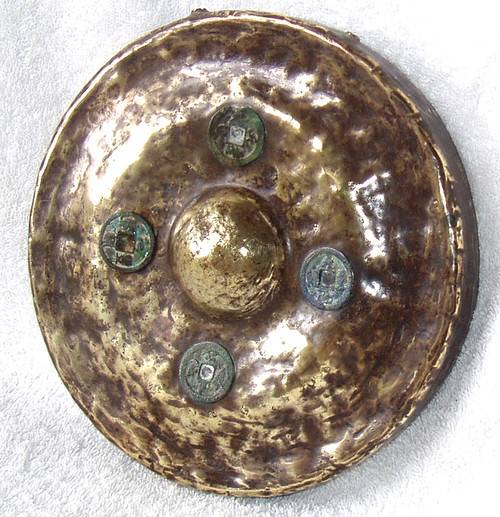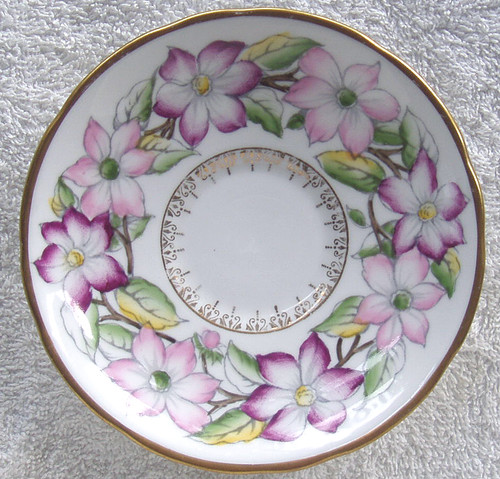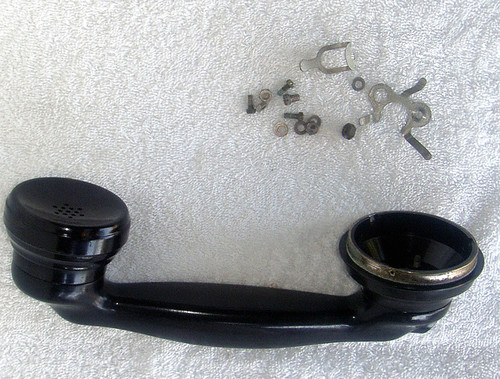BACKGROUND HISTORY
This is a traditionally hand crafted gong and these were often to be found in the homes of affluent families across South East Asia as a status symbol but these gongs had a secondary use, no not as a musical instrument or "dinner bell", but in fact these gongs were sounded to scare away "evil spirits//bad demons" from the home, much like fire works are often used for the same purpose in contemporary times - ever wondered why people light fireworks at the strangest of times, especially in the city areas? It is not for entertainment but to scare off those nasties that may bring bad fortune upon you.
Actually you don't necessarily need to sound the gong, just rubbing the gong is believed to bring good luck and fortune, you can still see manifestations of this belief system in modern times - if you pay a visit the large Bronze boar ( Il Porcellino) outside the old Sydney Hospital in Macquarie Street you immediately notice that the boar's nose has been rubbed so much that it is a bright shiny Yellow. That rubbing is done to bring good luck to the person doing the rubbing, not because they like rubbing boar noses!
This gong came from my wife's family (SE Asian origin) a LONG time ago, she believes it was originally obtained somewhere around Thailand in the 1940's although the coins attached to the gong suggest some Chinese influence/heritage as well.
There are four metal coins permanently attached to the gong, they have what appears to be Chinese writing on them and all have a square centre hole. We have not found anyone who can tell us the meanings of the symbols or characters on the coins but we are pretty sure it will be to do with bringing good fortune or at least, warding off bad fortune!
To sound the gong you will need a mallet, we are NOT supplying the original mallet because it "fell apart" years go, it was made from Bamboo with an animal skin covering something harder at the top - probably an animal bone.
We are offering the gong exactly as pictured, no gong and no support rope.
The same goes for the gong support rope, the original also perished over the years - from memory it was a fiberous material something like a jute. It is very easy to fed a simple rope through the two holes at the top of the gong, this rope is then supported by the gong stand - which is not included (it was also wooden, Bamboo actually, and it didn't make it beyond 40 odd years age before falling apart)
Please, in keeping with the overall age of this gong, don't use a nylon rope - it just won't look right! Find a nice piece of "real rope" and you are in business ...
So let's get down to the description in detail ...
METAL ALLOY GONG
Origins: South East Asia, most likely Thailand (according to my wife)
Size: 8 inches (200mm) diameter x 1" (25mm) deep
Metal wall thickness is 2.75mm - this is one very tough gong!
Total gong weight: 400g
Composition (we are not metallurgists, possibly incorrect information here!)
Solid metal alloy gong body which appears to be alloy Brass (based on the Yellowish patina) although some people have told us this could also be Bronze - notice the uneven Yellow on the surface, yes I have spent HOURS trying to "improve" the finish (we just don't like a dull looking gong!) but geez it was hard work! Rubbing for many hours by hand (no chemicals used or machine polishers - just loads of rubbing!) and still there are these darker areas which just would not come up Yellow. Rubbing the finger over this surface and it feels a little "waxy" but it has definitely NOT seen a modern clear lacquer of any kind.
I must say that when the light hits this gong "just right" it does look rather spectacular - the contrasting Yellows and darker areas give a sort of Tortoise shell effect
I have not attempted the same rubbing on the inside of the gong as it would be much more difficult to undertake and poses the question "Why bother?" as no-one would normally see the inside back of the gong in any case.
The four coins have been somehow attached to the gong, they are going nowhere fast as they are attached EXTREMELY securely (glue of some sort?) ... these coins have square centres and indistinct characters or symbols on each coin, the symbols being different between each coin. The metal used for these coins, when tarnished or oxidised, shows a Blue tinge which apparently tends to indicate a Copper metal or even perhaps Colbalt (less likely I would have thought)
But wait! there is a little mystery (actually a few mysteries ... read on) about the main metal. While it is clearly a Yellow shiny metal which appears as a Brown/Black when oxidised, the two holes at the top (for the supporting rope) are positively Copper with the unmistakeable bright Red//Orange colour of Copper, not Yellow at all - I find this just a little strange.
Obviously seriously hand beaten into shape (a LOT of work went into creating this gong) on the outside which makes reflected light bounce around in all directions - nice! Perhaps this enhances the gong's purpose in fending off the "evil ones" and even the two rope holes at the top have been hand created and amazingly these holes have been punched out from the INSIDE of the gong - that's one very difficult way to make a hole through the metal I would have thought. You can tell the holes have been created from the inside because the outer metal is pushed outwards and no efforts have been made to make the metal flush. There is no way in the world these two holes were created with a hand or power tool from the outside of the gong wall, they look to have been "punched out" from inside, actually they are a bit like bullet holes! Sort of fits the time period, 1940's in Thailand (a non-serious comment)
Musically, I wouldn't bother personally! Sure it makes a reasonable "GONG" sound, probably good enough to keep the evil spirits away (and annoy the neighbours I guess) but not what I would consider a serious contender in the musical instrument world.
Keep in mind that the new (lucky) owner will need to provide their own gong support rope and of course have an existing gong frame or at the least, somewhere from which to hang the gong.
Again, we must repeat, there is NO mallet is provided - try to get something authentic and vintage (if possible)
Keep the mallet close at hand, you never know when there may be a need to fend off the "bad spirits" and enjoy continuing good fortune. Just received the electricity bill? give the gong a rub and who know's what may happen ...
At this point you may be thinking "Hey if he is finding a new home for his gong, won't they have bad fortune?" Not so, my wife is VERY into many forms of symbolic good fortune and we are "well protected" by Indian elephants, Budda's and Chinese symbols of many types, special dried leaves (yes, dried leaves) and so much more ... one less instrument of good fortune will not make a great deal of difference here!
COSMETIC CONDITION:
Some may say "sacrilege!" because I have been very busy rubbing away that old dull patina, I have spent literally hours hand rubbing this gong to improve it's look when reflecting light (and hopefully will be experiencing masses of good fortune!)
The gong is not physically damaged in any way, actually this is one VERY tough gong and it would take a lot of force to damage it.
All four coins are in place very securely - one coin I felt was just a little loose so I have applied clear epoxy cement (Araldite) to the CENTRE square area of that coin, just to make sure it stays in place. I didn't want to risk losing a coin in the future and perhaps reducing the effectiveness of the gong in scaring away the "evil ones"
Now that the description and photograph taking is complete, I have placed the gong into a completely sealed clear plastic packet to reduce the speed of oxidisation of the metal - I spent a lot of time giving it a good rub so I want the "look" to remain as long as possible! It will be supplied in the same sealed clear plastic packet.











